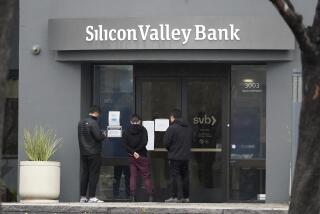Agency Puts Limits on San Clemente Savings Operation
- Share via
SAN CLEMENTE — Federal thrift regulators have restricted certain operations of San Clemente Savings Bank, including making large home loans, because the institution does not meet recently enacted capital requirements, the institution said Monday.
In a filing with the Securities and Exchange Commission, San Clemente Savings said that as a result it has asked the parent, American Pacesetter in Newport Beach, to inject additional capital. The thrift also plans to sell some assets to raise funds.
The restrictive order from the U.S. Office of Thrift Supervision prohibits the S&L; from declaring dividends, increasing executive salaries, making single-family home loans of more than $300,000, selling large assets without regulatory approval or transacting business with affiliated parties.
“It’s somewhat inconvenient, but I understand what they’re doing,” said John R. Polen, the thrift’s president.
He said that the restrictions, imposed after regulators rejected the S&L;’s plan to raise the needed cash by early next year, have no major impact on the S&L;’s activities. He said the thrift makes few home loans above $300,000.
The action against San Clemente Savings is part of a larger nationwide regulatory effort to restrict operations of S&Ls; that do not meet the three tough capital tests imposed as part of the law passed by Congress in August to rescue the thrift deposit insurance system.
In San Clemente Savings’ case, the thrift does not meet one capital test, specifically relating to the riskiness of its assets. Polen said the S&L; needs to come up with more than $2 million in capital to comply with the capital rules. The thrift expects to raise the money by the end of June, he said.
San Clemente Savings has $12.8 million in capital and easily meets two of the three tests, Polen said. But the thrift needs about $15 million in capital to comply with the risk-based test, he said.
San Clemente Savings, which has $325 million in assets and six branches, has built up expertise in loans to small home builders and real estate joint ventures, primarily apartment and commercial loans.
Regulators, however, consider those kind of loans and investments to be riskier than single-family home lending and require institutions to have more than the usual amount of capital, their final reserve against losses.
Under the new thrift law, S&Ls; have five years to meet capital standards, Polen said. San Clemente Savings submitted a capital plan to the OTS showing its intention to meet the so-called risk-based test by early next year.
“But the OTS has developed a policy that says they want the parent company to step in and make capital contributions sooner,” he said. That is why the S&L; is seeking a cash infusion from American Pacesetter.
To encourage compliance, OTS limits a thrift’s operations, and Polen said the restrictions imposed on San Clemente Savings were close to what the S&L; was doing on its own to raise its risk-based capital level anyway.
He said the S&L; already has commitments to sell some of its commercial and major apartment investments and loans to raise the needed cash.
American Pacesetter, which consists almost entirely of the S&L;, may see its profits fall as it works to comply with the order, he said.
Nearly two years ago, the parent firm spun off its profitable Pacesetter Homes subsidiary and its Pacesetter Business Properties division to its shareholders.
More to Read
Inside the business of entertainment
The Wide Shot brings you news, analysis and insights on everything from streaming wars to production — and what it all means for the future.
You may occasionally receive promotional content from the Los Angeles Times.










